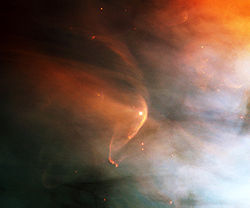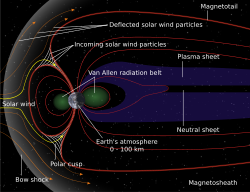Solar wind
The solar wind is a stream of charged particles from the Sun. It is made of charged protons, electrons and plasma shot out of the Sun, and creates the heliosphere. The wind is shot out at hypersonic speed, so fast that it can travel the whole length of the Solar System, nearly one light year.
The particles are dangerous to astronauts and spacecraft. The Earth's magnetic field absorbs or soaks up a lot of the solar wind causing the aurora, the Northern lights and Southern lights.
At a distance of more than a few solar radii from the Sun, the solar wind reaches speeds of 250 to 750 kilometers per second and is supersonic.[2]
A disturbance in the solar wind is called a solar storm. Sometimes it causes a geomagnetic storm. Such a storm in 1989 brought down the Quebec electric power grid[3] and put the entire province in darkness. The largest recorded geomagnetic storm was in September 1–2, 1859.[4] If we were to have another as strong as that one it might cause up to 2 trillion dollars damage.
Solar wind also causes the tail of a comet. When the comet is close enough to the sun that the heat evaporates some of the comet's ice, the motion of the solar wind causes the resulting water vapor and space dust to stream away from the comet. Because it is blown by the solar wind, the comet's tail does not trail behind it, but always points directly away from the sun.
The Solar Wind Composition Experiment of the Apollo program studied the atoms in the solar wind.
Solar Wind Media
Laboratory simulation of the magnetosphere's influence on the solar wind; these aurora-like Birkeland currents were created in a terrella, a magnetised anode globe in an evacuated chamber.
This is thought to show the solar wind from the star L.L. Orionis generating a bow shock (the bright arc).
Parker Solar Probe observed switchbacks — traveling disturbances in the solar wind that caused the magnetic field to bend back on itself.
The heliospheric current sheet results from the influence of the Sun's rotating magnetic field on the plasma in the solar wind.
Schematic of Earth's magnetosphere. The solar wind flows from left to right.
NASA animation of the Parker Solar Probe passing through the Sun's corona. Inside the corona's boundary, its Alfvén surface, plasma waves travel back and forth to the Sun's surface.
References
- ↑ McComas, D. J.; Elliott, H. A.; Schwadron, N. A.; Gosling, J. T.; Skoug, R. M.; Goldstein, B. E. (2003-05-15). "The three-dimensional solar wind around solar maximum". Geophysical Research Letters. 30 (10): 1517. Bibcode:2003GeoRL..30.1517M. doi:10.1029/2003GL017136. ISSN 1944-8007. S2CID 128577338.
- ↑ McGraw-Hill Encyclopedia of Science & Technology, 8th ed. 1997. 16, 685.
- ↑ Boteler, D. H. (October 2019), "A 21st Century View of the March 1989 Magnetic Storm", Space Weather, 17 (10): 1427–1441, Bibcode:2019SpWea..17.1427B, doi:10.1029/2019SW002278, S2CID 209943101
- ↑ Tsurutani, B. T.; Gonzalez, W. D.; Lakhina, G. S.; Alex, S. (July 2003), "The extreme magnetic storm of 1–2 September 1859", Journal of Geophysical Research: Space Physics, 108 (A7): 1268, Bibcode:2003JGRA..108.1268T, doi:10.1029/2002JA009504








